OAS Node #1 [9/21]: David Spaner
 Tuesday, September 18, 2012 at 09:26PM
Tuesday, September 18, 2012 at 09:26PM 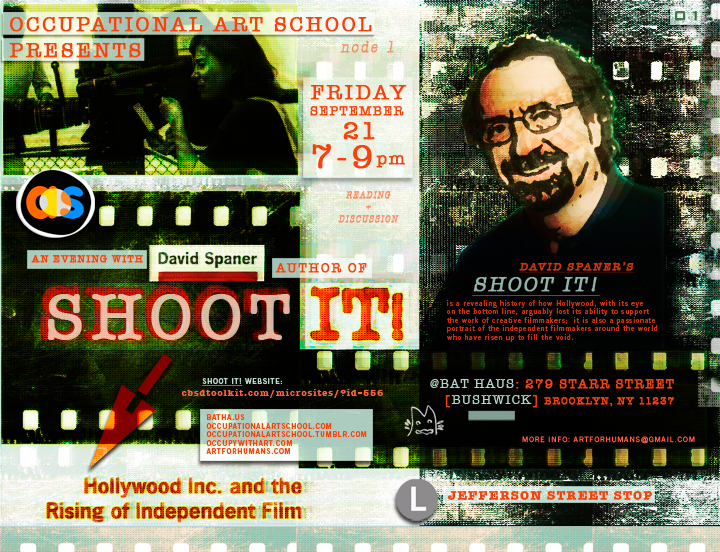
 admin |
admin |  Post a Comment |
Post a Comment |  DAVID SPANER,
DAVID SPANER,  bat haus,
bat haus,  occupational art school in
occupational art school in  CINEMA,
CINEMA,  discussion,
discussion,  readings
readings The Occupy with Art blog provides updates on projects in progress, opinion articles about art-related issues and OWS, useful tools built by artists for the movement, new features on the website, and requests for assistance. To submit a post, contact us at occupationalartschool(at)gmail(dot)com .
 Tuesday, September 18, 2012 at 09:26PM
Tuesday, September 18, 2012 at 09:26PM 
 DAVID SPANER,
DAVID SPANER,  bat haus,
bat haus,  occupational art school in
occupational art school in  CINEMA,
CINEMA,  discussion,
discussion,  readings
readings  Monday, September 10, 2012 at 09:35PM
Monday, September 10, 2012 at 09:35PM 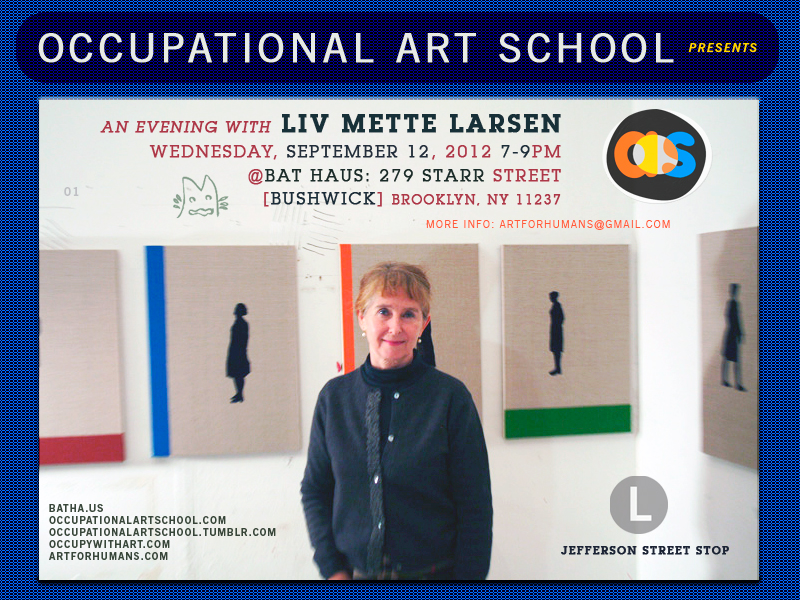
The Occupational Art School Node 1 at Bat Haus is pleased to present an evening with Liv Mette Larsen, accomplished Norwegian-born painter based in Bushwick and Berlin. From 7-9PM on Wednesday, September 12, 2012, OASN1@BH will host a casual conversation with the artist and introduction to her Scrap Metal series, which is inspired by the scenes she has encountered during her recent stints working and living in Bushwick/Brooklyn/NYC.
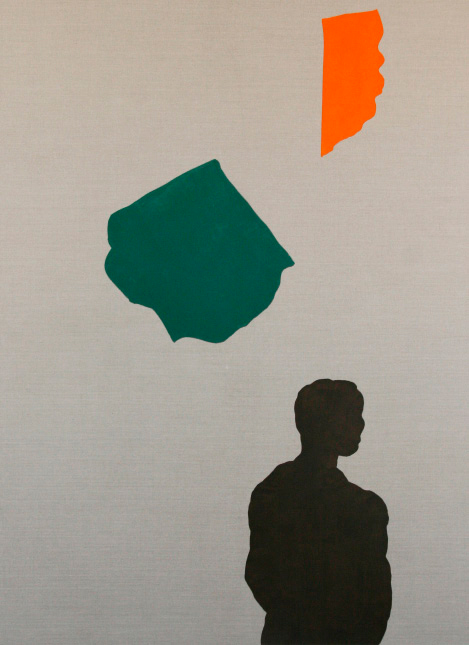 Painting by Liv Mette Larsen
Painting by Liv Mette Larsen
Download a 2011 catalog of Liv Mette Larsen’s “Scrap Metal” series HERE.
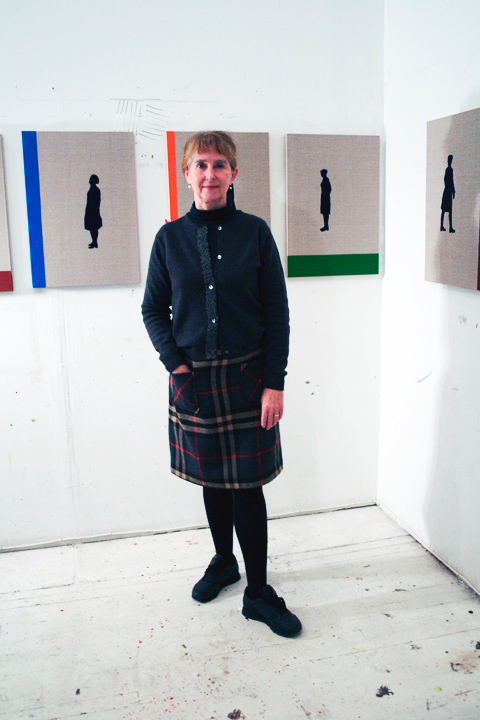 Photo by Paul McLean
Photo by Paul McLean
[Catalog Essay]:
LIV METTE LARSEN: SCRAP METAL [NEW YORK PAINTINGS]
In a career spanning more than thirty years, Larsen’s intuitive paintings, watercolors and drawings establish an energetic dialogue about perception and the transitory moments of life. Working primarily in monochrome silhouettes, she employs alternating scales to reconstruct the subjective realities of her narratives. Instead she proposes an inductive perspective, abstracting people and things from her daily encounters that reflect the circumstances of Larsen’s practice. Her paintings dissolve the boundaries between figuration and abstraction, with objects transforming fluidly into organic geometric forms. She paints with densely applied egg tempera to create the illusion of volume to allow isolated elements to become vivid archetypal forms and graphic signs.Throughout her recent works, urban space and the ways in which people engage with it have been a primary concern. Drawing inspiration from the fleeting moments of everyday life, figures are devoid of context, either standing alone or with blocks of color. In Big Men (2011), heavily bundled men isolated against the canvas appear to be engaged in a ritualistic dance, alternately moving closer and further away. Likewise in Berlin Blue Abstract Walking (2010), an unknown woman, identifiable only by her profile, poses in each canvas. Reduced to strictly physical cues, each stance ranges from contemplative to interrogative. This series takes its title from a specific blue that was discovered by eighteenth-century alchemists working in the Prussian capital.From anonymous figures to pared-down industrial environments, she seeks to integrate the identifying characteristics of her location with her works. Larsen approaches the subway as a linear system reminiscent of Mondrian’s urban grids while in Scrap Metal and Scrap Metal Heap (2011) Larsen records the scrap metal heaps that were immediately outside of the window of her Brooklyn studio. Reduced to abstract swathes of bright yellow, blue, orange, and green, the utility of each jagged piece dissolves into an amoeboid shape. In Smith Street (2011), the blurred relationship between figure and ground disorients perspective. Although Larsen makes reference to a specific location, her paintings examine the fundamental relationships between people and their surroundings, preserving initial observations and glimpses to allow for prolonged reflection.Liv Mette Larsen was born in Oslo, Norway in 1952 and attended the Oslo SHKS School of Art and Crafts. From 1978-84 she studied at the Berlin Hochschule für Künste (UDK). In 1992 she won Berlin’s Senate Cultural Affairs Department Grant and Norway’s Vederlagsfondet Grant in 1994, 1996, 1997 and 2006. She received additional grants from the Norwegian Cultural Council in 2000, 2004 and 2006. Recent solo exhibitions include Literaturhaus, Salzburg, Austria (2006), Galerie Kai Hilgemann, Berlin, Germany (2007, 2008, 2010, 2011, 2012), Galeria Fruela, Madrid, Spain (2008) and Helac Fine Art, New York, USA (2011).She has exhibited internationally for over three decades and her work is included in major public and private collections.
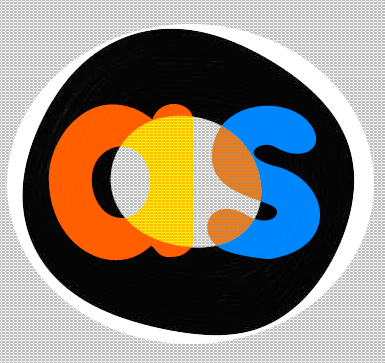
 Wednesday, August 29, 2012 at 11:39AM
Wednesday, August 29, 2012 at 11:39AM 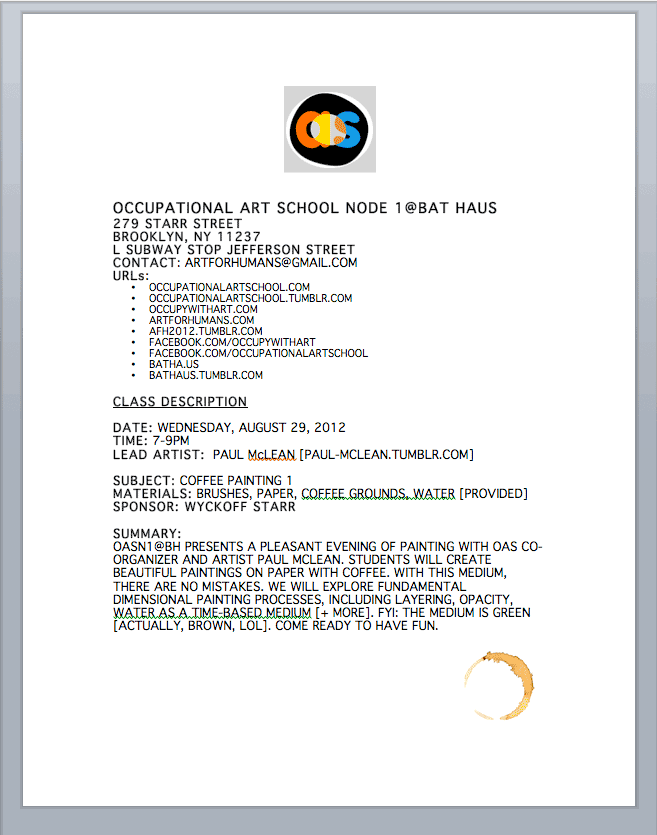 Click image to download doc.Info on this evening's Occupational Art School "COFFEE PAINTING" class @ Bat Haus Coworking Space, "COFFEE PAINTING." Should be a ton'o'fun. All you have to do is bring yourself + a great attitude. FYI: First OASN1 class is always free!
Click image to download doc.Info on this evening's Occupational Art School "COFFEE PAINTING" class @ Bat Haus Coworking Space, "COFFEE PAINTING." Should be a ton'o'fun. All you have to do is bring yourself + a great attitude. FYI: First OASN1 class is always free!
 bat haus,
bat haus,  coffee painting,
coffee painting,  occupational art school in
occupational art school in  education,
education,  paintings
paintings  Tuesday, August 28, 2012 at 02:23PM
Tuesday, August 28, 2012 at 02:23PM 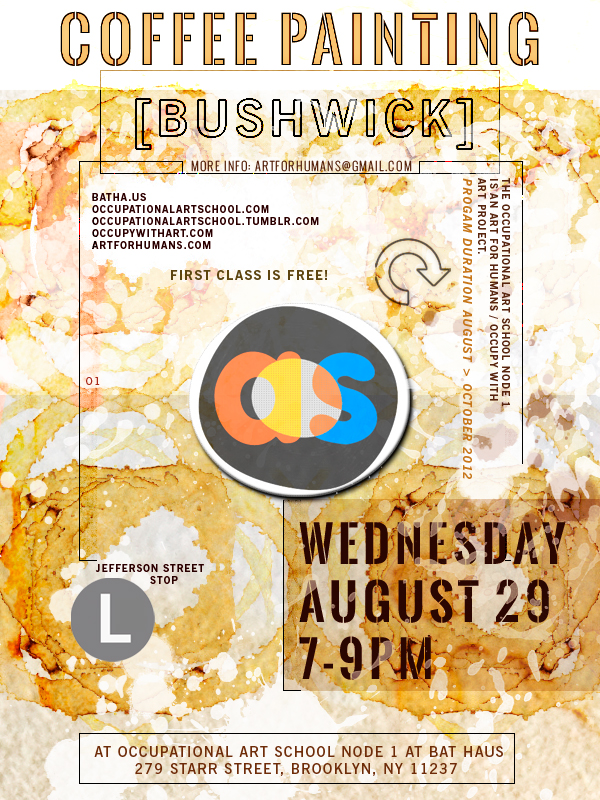
Sponsored by the Wyckoff Starr coffee shop.
 OAS Node #1,
OAS Node #1,  bat haus,
bat haus,  classes,
classes,  coffee painting in
coffee painting in  education,
education,  paintings
paintings  Monday, August 27, 2012 at 07:49AM
Monday, August 27, 2012 at 07:49AM [DisciplineAriel performs at OASN1@BH Saturday, August 25, 2012]
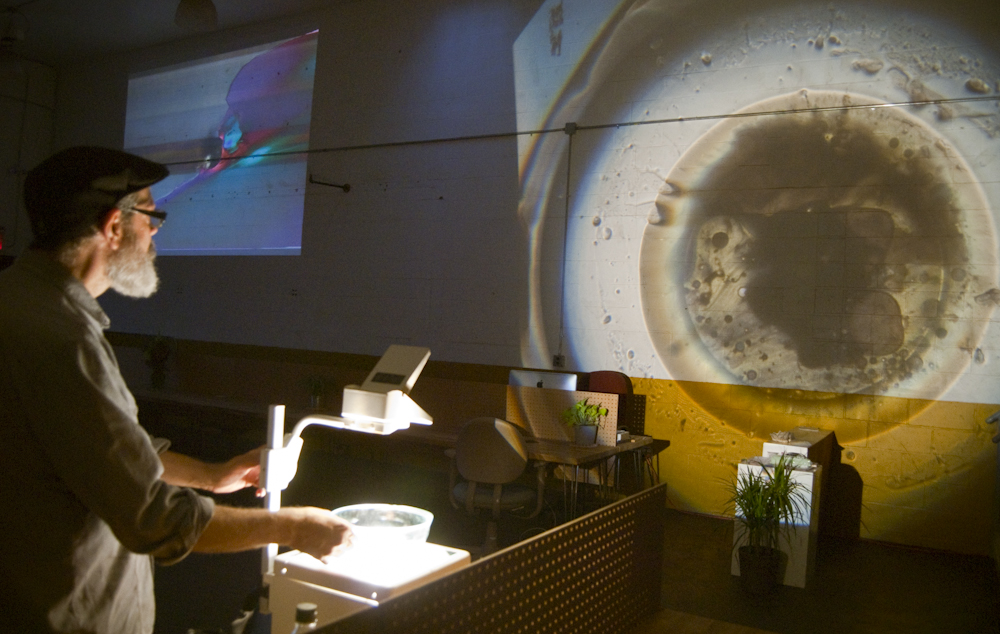 Michael Barron on overhead projector. Click image to see Bat Haus photoset.[Performance Elements]:
Michael Barron on overhead projector. Click image to see Bat Haus photoset.[Performance Elements]:
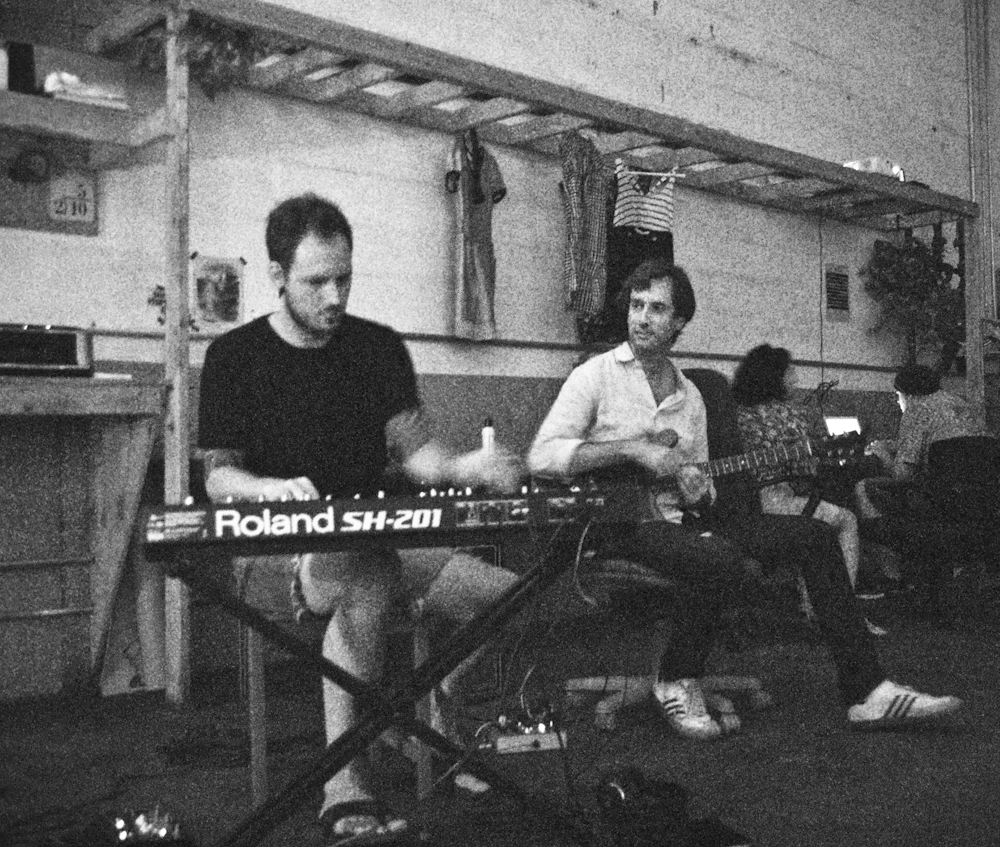 Wilson Novitzki, Adam Caine
Wilson Novitzki, Adam Caine
[LINKS]:
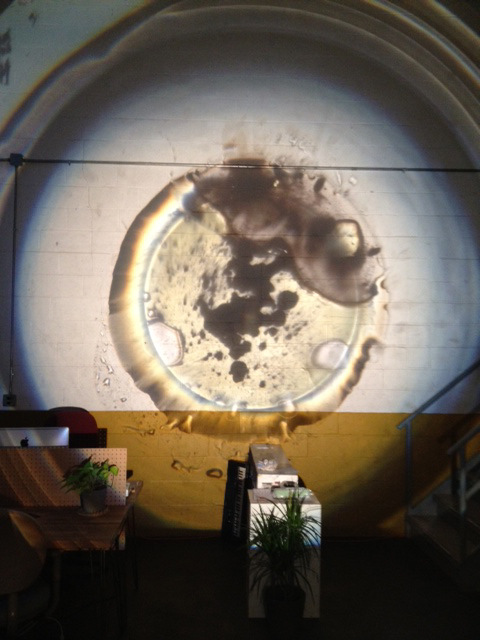 Overhead projection, iteration 1 [PJM][Narrative]
Overhead projection, iteration 1 [PJM][Narrative]
DisciplineAriel began in early summer 2012 as a "Borderless Art" proposition + mobile media collaboration for Bushwick-based musician and composer Wilson Novitzki and visual artist Paul McLean. The process involved several informal exchanges at Wyckoff-Starr, plus emails, phone calls and a pre-production meeting and 4d demonstration. Web archive links were exchanged and reviewed.
During a two-month European tour with renowned DIY artist R. Stevie Moore, Novitzki composed short electronic and guitar pieces on synthesizer and iPAD. These pieces were uploaded to a Tumblr created for DisciplineAriel by McLean, who added entries featuring "outside" content - from three sources:
These satellite or context threads also in real time sequences featured neo-epic or -journeyman components and intersecting trajectories. McLean contributed digital still and moving images, as well as photo documentation of "HOME," i.e., Bushwick, the project's point of origin.
The DisciplineAriel performance for Occupational Art School Node 1 at Bat Haus constitutes a "Welcome Home" party for Wilson; a version of "Talking Story;" a prototyping proof for the particular kind of collaboration Novitzi and McLean practice(d); an invitation to further expand the collaboration to include both random and "staged" participation by OASN1 artists [+]
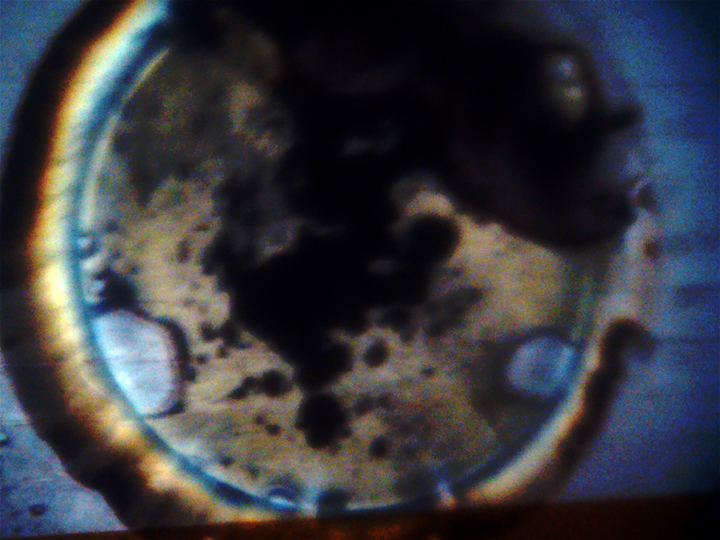 Overhead projection [operator transition phase]
Overhead projection [operator transition phase]
[PHOTO & VIDEO DOCUMENTATION]: Natalie Chan, Cody Sullivan, JenJoy Roybal, Michael Barron, Paul McLean [+]

 Friday, August 24, 2012 at 10:27AM
Friday, August 24, 2012 at 10:27AM 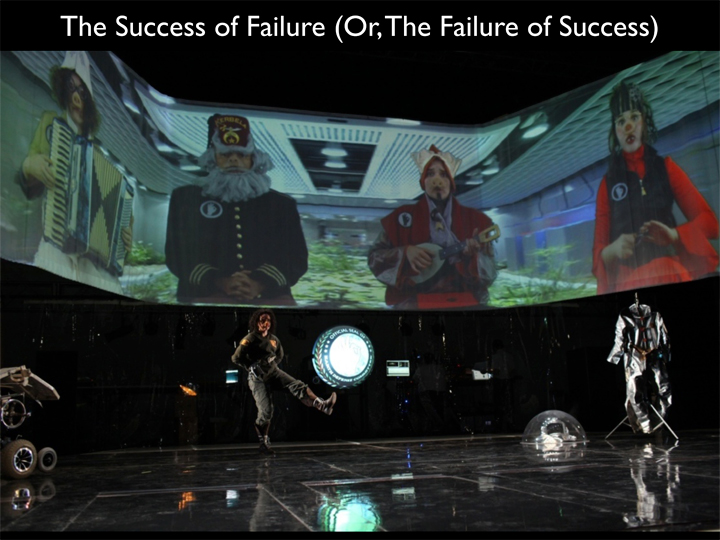 Page 10 of Jeff Sugg's portfolio. Click image to download the PDF of Jeff's portfolio.
Page 10 of Jeff Sugg's portfolio. Click image to download the PDF of Jeff's portfolio.
Whatever It Maybe ∞
Jeff Sugg at OASN1@BH (August 22, 2012)
By Paul McLean
Jeff Sugg parked his street-painted punk van directly in front of Bat Haus about an hour before his Occupational Art School Node 1 presentation was slated to begin. After a quick smoke, Jeff - master theatrical projectionist, designer, artist, visionary and enabler of visionaries [+] - commenced to unload the gear he would be using during "Digitizing Theater" into the Bat Haus space. For tonight's program, OASN1 co-organizer Chris Moylan had supplied a digital projector, which Jeff would use to share his slideshow, movies and to create a real-time vignette, an immaterial hand-operated & projected reference table for Sugg's favorite inspirational picture texts. Sugg's influences? Sviboda, Bucky Fuller, Da Vinci...
I provided an overhead projector. The overhead throws a representation of Peter Cooper by Shane Kennedy in the rear of the screening area. The Cooper is our OASN1@BH mascot. Alice Cooper's "School's Out" is the OAS theme song, though I haven't shared that bit of intel with anyone yet, except for you, dear reader.
Tonight (that night), we're in for a treat.
∞
 Wednesday, August 22, 2012 at 05:28AM
Wednesday, August 22, 2012 at 05:28AM 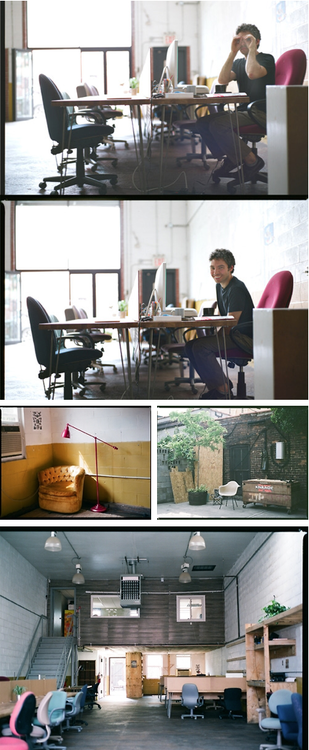 Here is the current look of Bat Haus, a co-working space and community nexus in Bushwick.[FROM THE BAT HAUS BLOG]:
Here is the current look of Bat Haus, a co-working space and community nexus in Bushwick.[FROM THE BAT HAUS BLOG]:
Bat Haus is located at 279 Starr Street, Brooklyn NY, 11237 (Bushwick). We are right off Jefferson stop on L train, about 25 mins away from Manhattan.
Here are some of our neighbors:
Bat Haus is a coworking space (what is that?), co-founded by Cody Sullivan and Natalie Chan. You can find our little story here and an article with Natalie’s crazy jumping pics here.

 BUSHWICK,
BUSHWICK,  bat haus,
bat haus,  occupational art school in
occupational art school in  alliance,
alliance,  alternate economy,
alternate economy,  co-work,
co-work,  fun
fun  Tuesday, August 21, 2012 at 09:54AM
Tuesday, August 21, 2012 at 09:54AM  Eric Leiser [OAS Node 1 @Bat Haus, August 17, 2012 (Photo by Paul McLean)]
Eric Leiser [OAS Node 1 @Bat Haus, August 17, 2012 (Photo by Paul McLean)]
"Holography: Merging the Real and Virtual for the 21st Century"
Eric Leiser, Occupational Art School, Aug. 17
By Christopher Moylan
So much of the art that draws large crowds to museums and galleries is of the sort that demonstrates a breakthrough in the understanding of human perception. Egyptian art in its various stages, Early Renaissance painting, Impressionism, Pointillism, and Cubism, as well as early photography and film combine the intrinsic appeal of the image with a more abstract, historical interest in how the image was made and what this process says about the ways in which people experience the world.
Of course, the works that are so widely appreciated are not simply technical demonstrations or curiosities. There is something transcendent and simply perfect in Piero della Francesca’s “The Flagellation of Christ,” as there is in Seurat’s “The Bathers at Arsnieres”, Monet’s Haystacks, and so on. Every period in art history has its corresponding high points, and it could be argued that any serious work of art, in any medium, reveals something about the workings of human perception. Nonetheless, certain changes in art practice are striking and remain so through time. The development of linear perspective in the early Renaissance represents a fundamental change in the understanding of the picture plane, and of how the eye constructs meaning out of environmental information. Anyone can see this, and anyone looking at one of Piero’s paintings can take part, intuitively and vicariously, in the pleasure of this breakthrough.
When a person who has little or no academic background in art history volunteers that Impressionism is his favorite kind of art, this is not a cliché, at least not for him or her. It’s a statement of affiliation to something powerful and continuously new; this is beautiful and interesting, and I don’t care what you say, I like it. High Modernism may be the last period in art history to be widely associated with this kind of perceptual advance. (There may be others; Clement Greenberg and Walter Gombrich can sort out what and when.) No doubt not many in the huge crowds that line up for a large scale exhibition of Picasso’s work might have some difficulty discussing the importance of duration, multiple perspective and geometric configuration in his Cubist phase, but they know something of all that and they find it fascinating.
So after Impressionism, Pointillism, Cubism, what next?
Holography, perhaps.
This may seem unlikely; holography is most often seen in science fiction movies, and even that context it’s a novelty or gimmick. Eric Leiser, speaking at Occupational Art School, had little patience with that view of the technology. A filmmaker and pioneer in holographic technology, he is developing holography as an art form and in the process investigating the metaphysical properties of light as material information. A talk which was originally planned as a demonstration and lesson in basic holographic process, along with a sample of Leiser’s holographic images, quickly turned into something spiritual and yet utterly practical.
A holographic image, he explained, is not merely a technical process, splitting a laser beam against mirrors so that the light drapes the surface of the object while another beam strikes the emulsion. It is a thing, a material form of light as information. This thingness is in some processes directly apparent. With haptic holography, for instance, the projected energy is so dense that one can touch it. For that matter, one can construct a building with haptic holography, or a bridge, a structure that can be just as useful as something made of brick or wood but with the advantage that it will vanish when the object is no longer needed, leaving no trace on the site where it stood. Haptic or cymatic holography uses ultrasonic waves to give density, tactile resistance, and thingness to a holographic image.
All of these processes dissolve the constructs that delineate experience, impose boundaries and markers—me-you, this-that, signifier-signified—that are purely expedients of our cognitive makeup. We anthropomorphize the signified, make sense of it with the thinking, experiencing equipment we have—eyes, nerves, brain and so on. The usual separation of inert and living objects begins to dissolve in holography. The holographic image reveals that every object is constituted with energy in different configurations and this energy is interactive—dynamic. The rock doesn’t just sit there, no more than the person does. It acts, and in a sense, speaks. The hologram captures this speech within the spooky quantum physics of light waves.
In quantum physics information is reality or, as Rob Braynton puts it, “our reality is just an expression of the information encoded within the underlying fabric of quantum fields” (“Imagining the Tenth Dimension” blogspot). A great deal of research, distilled to an evocative phrase, has it that this universe is a hologram of a fifth dimension. The holographic images Eric Leiser makes in his studio offer glimpses of this quantum reality. The holograph is not an image of the subject, it is the real of the subject.
The real, in this way of thinking, is a far cry from the horrific fissure in the signifying system that it is made out to be by Lacan, Zizek and their followers. For Zizek, the thinged word is Das Ding, a monstrous something that appears in a crack in the signifying system, an impossible glimpse at noumenal reality. In this view, the signified and signifier cannot meet; we shouldn’t be able to bite into the word apple. For Leiser, the real is not threatening at all. It is fascinating, approachable and often quite beautiful. With lasers costing only a few dollars, it is also affordable; almost anybody can make one.
But, if I have it right, this is almost like saying a prayer is free, anybody can say one. There is more to it than that.
The art of holography, as Eric presented it, seemed the art of spiritual reflexivity. A way of thinking of the soul in his view, for example, is to think of a hologram making a hologram of itself. Similarly, we can think of the brain not as an organic system encased in a hard shell, but as a star system with its own pulsars and black holes, its vast array of energy transfers and informational novae where holographic interference patterns establish themselves in dimensions that it hurts the ordinary brain to consider. Everything, everywhere we look is multivalent, dynamic and endlessly possible. Our idea of energy as such need not be restricted to oil and gas and nuclear; a room is filled with endless energy, should we choose to access it—and, according to Mr. Leiser, the time when we will do so isn’t that far off.
To return to art in its usual sense; there were pictures, lovely pictures projected on the wall of Bat Haus. One could tilt the ipod from which an image was projected and the image would morph. The possibilities for abstraction—a kind of abstraction in physics—are just beginning to be explored, as is the relation of holography to traditional media. Eric has experimented with projecting holographic images on painted canvases; the possibilities along those line are intriguing. The development of three dimensional printing opens new possibilities for the book, for sculpture and so on. The necessary condition for such possibilities to be realized, however, is that holography be situated within art practice and discourse.
Eric is remarkably well placed to do just that. A graduate of CalArts with an extensive technical background, he is the founding member of Albino Fawn Productions along with his brother, composer Jeffrey Leiser. He has exhibited widely in the U.S. and around the world. His work has appeared in major museums and art festivals. The films he and his brother have produced are widely distributed. He was about to depart for a film festival in Hiroshima at the time of his talk, and his work was on exhibit at "Hologalactic" at All Things Project at The People's Church of Greenwich Village (curated by Sam Kho and Susan Joyce of Fringe Exhibitions) He is extremely productive.
It is unlikely, however, that Eric thinks much about career, or money or even little things like dinner or sleep. He strikes me, anyway, as someone completely liberated by work. It is appropriate for him to appear in an Occupy or Occupational space because he is so liberated and so generous; I imagine that if the fellow selling him a hot dog or cup of coffee asked about holograms that Eric would sketch it out for him, teach the basics of holographic technique on the spot and set him up with the url addresses of sites where he could pursue this further. One can quarrel with all of the metaphysical ideas Eric generates, if one choses, but the good news remains. He, and lots of the people, are at work outside the capitalist system of mega-profit and celebrity self-aggrandizement, busy transforming not only our understanding of perceptual systems in art, but our understanding of the human. The technology for unlimited energy supply may be a ways off, but the vision of separating energy from exploitation and violence is pertinent and necessary right now. Eric’s holistic view of the production and hermeneutics of art are as far removed from current discourse in the art world as can be.
I am beginning to think that the art world of the oligarchic collectors and fashionistas is tilting on a precipice of crazy economic conditions and general cultural indifference. Be that as it may, the kinds of technical, spiritual and artistic explorations Eric Leiser is pioneering matter now and no doubt will matter increasingly as time goes by; the crowds will line up sooner or later.
 Wednesday, August 15, 2012 at 11:18PM
Wednesday, August 15, 2012 at 11:18PM 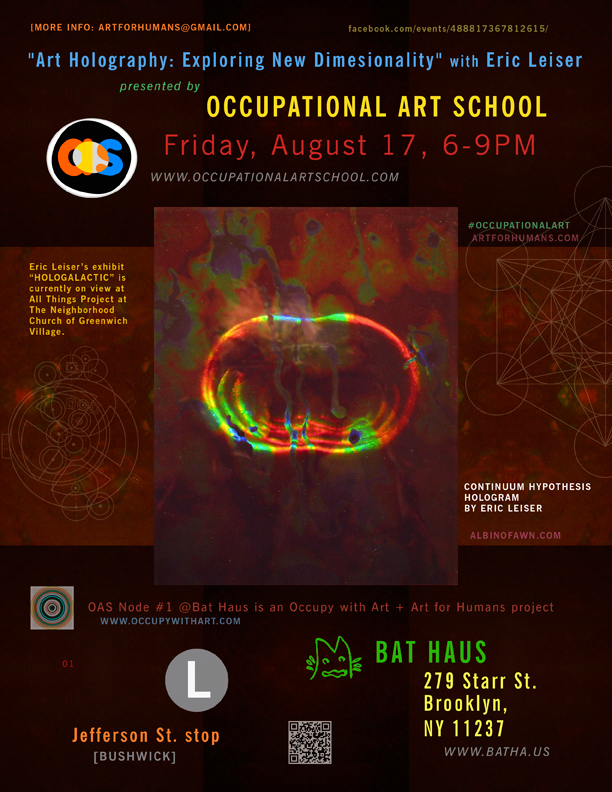
[FREE DOWNLOADS]
 Eeric leiser,
Eeric leiser,  bat haus,
bat haus,  flyers,
flyers,  occupational art school in
occupational art school in  posters
posters  Wednesday, August 15, 2012 at 11:13PM
Wednesday, August 15, 2012 at 11:13PM 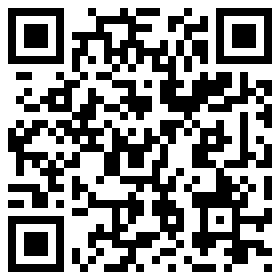
 QR Code,
QR Code,  bat haus,
bat haus,  eric leiser,
eric leiser,  occupational art school in
occupational art school in  technology
technology  Wednesday, August 15, 2012 at 03:41AM
Wednesday, August 15, 2012 at 03:41AM Launch of Occupational Art School Node #1
Occupy with Art, Art for Humans and Bat Haus are pleased to present an evening with multimedia artist Eric Leiser. Eric's latest show "Hologalactic" at All Things Project at The People's Church of Greenwich Village was curated by Sam Kho and Susan Joyce (Fringe Exhibitions) and featured new holograms, sculptures, moving images and paintings. Next week the artist will be traveling to Japan to attend a screening of his work at the Hiroshima International Animation Film Festival.
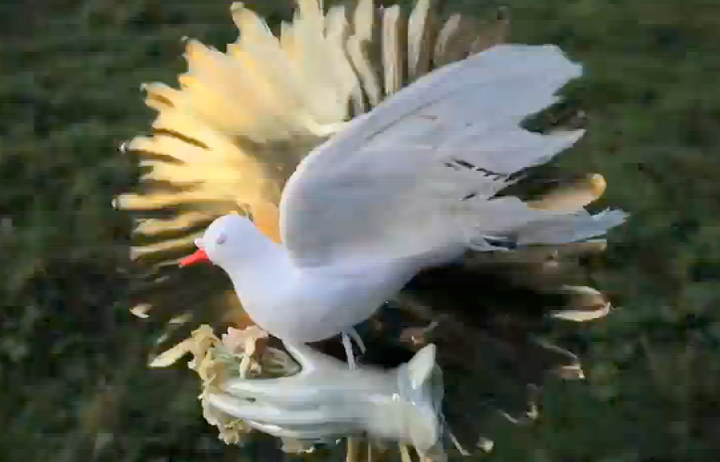 Film still by Eric Leiser
Film still by Eric Leiser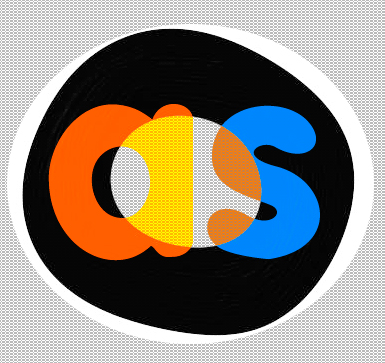
 bat haus,
bat haus,  eric leiser,
eric leiser,  holography,
holography,  occupational art school in
occupational art school in  animation,
animation,  more,
more,  teach-ins
teach-ins  Saturday, August 11, 2012 at 04:32PM
Saturday, August 11, 2012 at 04:32PM 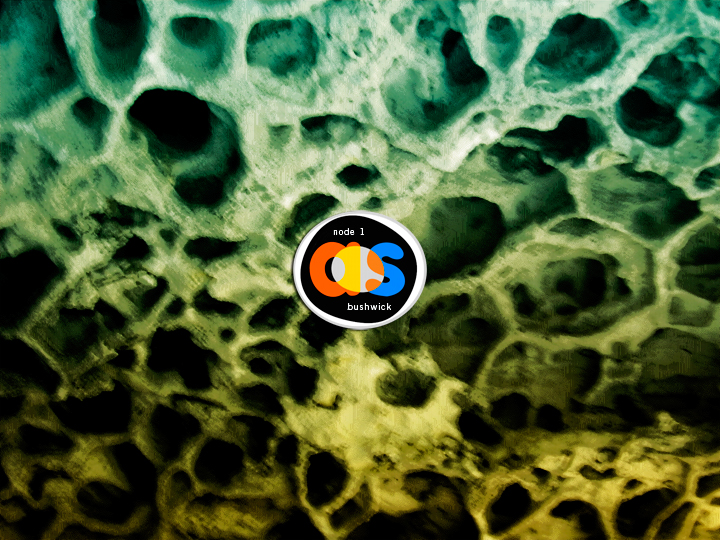
The pre-launch festivities at Occupational Art School Node #1 at Bat Haus in Bushwick on Thursday, August 9 felt "historic," according to OwA co-organizer Chris Moylan, one of the attendees. The performative presentation by Bold Jez had the air of an incantation. Jez made a point of acknowledging in subtle ways all those who have already sling-shot into other worlds (we all thought of Alex Carvalho)[+], and their presence was present in the beautiful array of artifacts from the anarchives in various states of display and array in the excellent Bat Haus co-work space. For example, when pointing to the big Magic Mountain canvas installed just inside the front door, and the MoMA banner draped in the center of the main room, Jez invited everyone who had worked on these "living documents," to use the 60 Wall term, to identify themselves and recount the experience of participating in the actions of emergent creativity that produced the banners. The sense of intimate community was palpable, almost tribal, amongst the original Arts & Culture crew/revGamers/Magic Mountaineers/Novads. [+] One of the evening's highlights - there were many - involved #theShamanGeneral otherwise known as #theColonizedIndigenous reading his now-monumental ana-poem (link to the original performance at Liberty Square will be added here) from the Etherpad he had just built, as an anarchivist vehicle for documenting his life in time. Noting that the tool enabled novadic participation as communercise. The magnificent Direct Action Flaneurs anchored the program to the street, & built a fine, sturdy bridge between the World, USA, NYC BK/Bushwick - L stop Jefferson & our interior architecture (dimensional & the Bat Haus'). The neighborhood folded into our event, ran over it, typed it, and cheered it. It was a joyful dance!
Friday, Jez & I met for debriefing. We covered a lot of territory. One of the most fruitful turns is the clarification of our program practicum at OASN1@BH, which will develop directly from the example provided by #theShamanGeneral otherwise known as #theColonizedIndigenous. From here throughout the residency Phase 1 (end of October), we will cite an event that's happened, then in some manner translate it for OASN1, then add (N+1) a teaching/learning component to the transmission.
Tonight [Saturday], we follow #TITMOTA 1 with the second iteration of #TITMOTA.
Now, some news about the next two OASN1@BH events.
∞
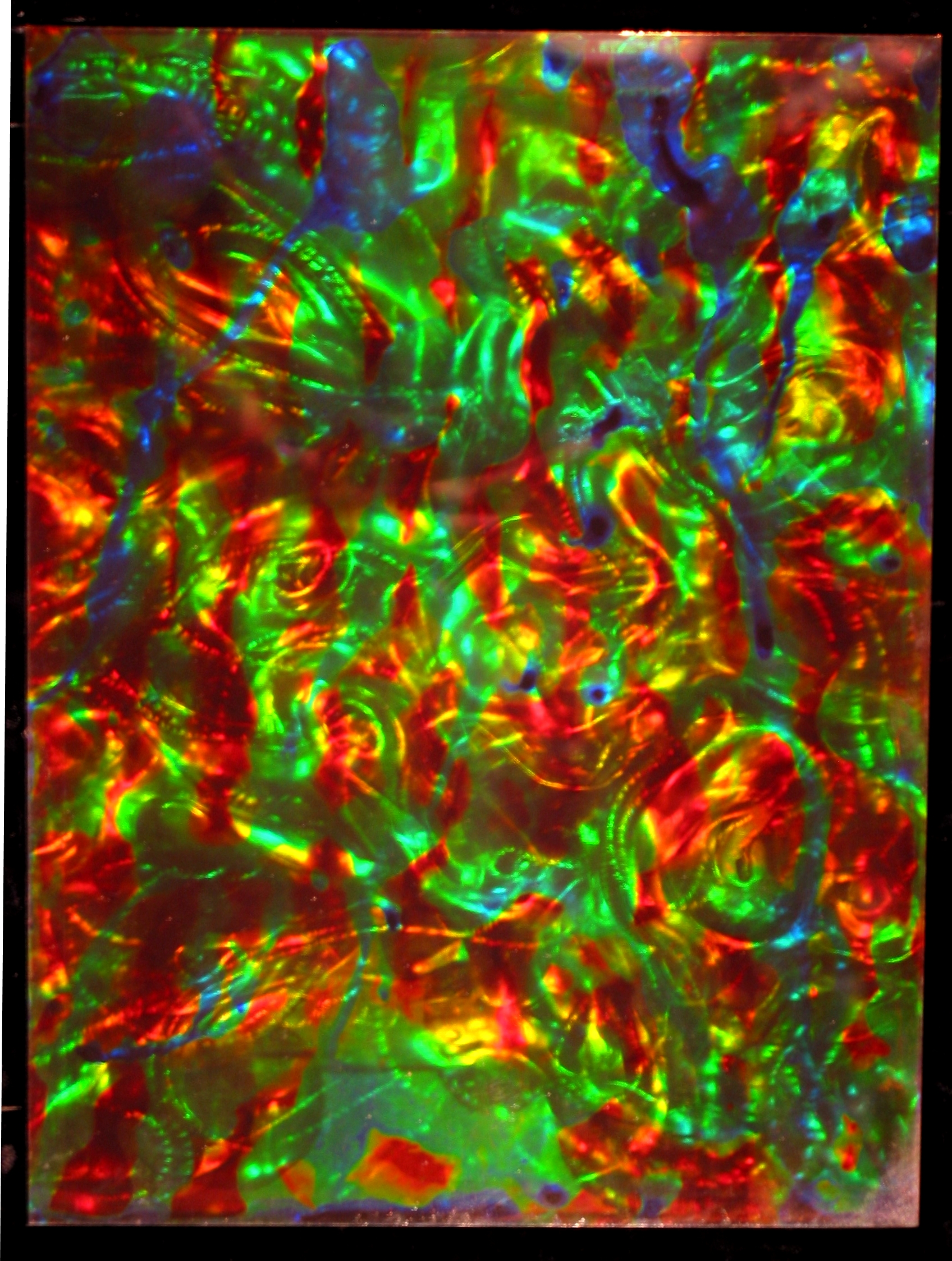 Eric Leiser, "Aleph 2"
Eric Leiser, "Aleph 2"
Friday, August 17 (9/17/2011 + 11 months), we will officially launch OASN1@BH with an evening "On Hologalactic." Eric Leiser will host a discussion about his recent show at All Things Project at Neighborhood Church of Greenwich Village, and his upcoming trip to Hiroshima, Japan, for the Hiroshima International Animation Film Festival. We'll be sharing more details between now & Friday. Here's Eric's impressive bio:
Eric Leiser is an award-winning artist, filmmaker, animator, puppeteer, writer, holographer and curator working in the LA, New York and London area. He has created 3 animated/live action feature films and 25 shorts as well as works that integrate painting, animation, puppetry, holography, sound and live performance/installation. Leiser is interested in how animation transforms perception when it is combined with live action space creating a fantastical/spiritually surrealistic quality.Eric's solo work has exhibited at MASS MoCA, Istanbul Modern Museum of Art, Thessaloniki Center for Contemporary Art, Ruben H. Fleet Space Center[2] in San Diego, California , (V & A) Victoria and Albert Museum, The MIT Museum,(BFI) British Film Institute, Anthology Film Archives, LA Film Forum, San Francisco Film Society, Fringe Exhibitions[4] in Los Angeles, California; Goldsmiths, University of London;[5] School of the Arts Institute of Chicago;[5] Central Academy of Fine Arts in Beijing, China, Live With Animals in New York City[6], Bourne Hall in Hastings, East Sussex, England along with international group shows. His holograms have been featured in in such publications such as a National Geographic Magazine.His films have screened at film festivals worldwide such as the Annecy International Film Festival, Hiroshima International Animation Film Festival, The Istanbul International Animated Film Festival, The San Francisco International Animated Film Festival, EXIS Experimental Film Festival, Seoul, Korea among others.He has made 25 short films, eight of which appear in the DVD release Eclectic Shorts by Eric Leiser, and three features: Faustbook, released April 25, 2006 by Vanguard Cinema, and Imagination, released theatrically in the US and Internationally in summer 2007 and February 2008 on DVD by Vanguard Cinema. Imagination was featured in the May 2008 issue of Animation Magazine.[8] "Glitch in the Grid" was released theatrically in the US and Internationally on October 2011 and February 2012 on DVD through Vangaurd Cinema.He is the founding member of Albino Fawn Productions along with his brother and collaborator musician Jeffrey Leiser.Eric is an alumni of CalArt's Experimental Animation program.For updates www.albinofawn.comNational Geographic article on Eric's hologram:http://tvblogs.nationalgeographic.com/2010/06/28/holographic-universe/
∞
On Wednesday August 22 OAS has confirmed Jeff Sugg as our first guest. We will discuss the ways Digital has altered theater, and theatrical production, its hierarchies, rehearsal patterns, selection processes [+]; as well as the possible new forms that may emerge from the phenomena in play. Here is Jeff's bio:
Jeff Sugg is a New York based artist, designer, and technical advisor. He is a co-founding member of the performance group, Accinosco, with Cynthia Hopkins and Jim Findlay and has co-designed their two critically acclaimed pieces, Accidental Nostalgia and Must Don't Whip 'Um.33 Variations (projections: Arena Stage, La Jolla Playhouse), The Slugbearers of Kayrol Island (co-set & projections: The Vineyard Theater), ¡El Conquistador!The Thomashefsky Project & Let Them Eat Cake/Of Thee I Sing (projections: San Francisco Symphony), Trece Días (sets & projections: San Francisco Mime Troupe) He has also worked as designer for multiple works with theater companies including: The Colllapsable Giraffe, Pig Iron Theater Company, DASS Dance, Transmission Projects. Music design: Natalie Cole (lights), and Natalie Merchant (lights). Other theater designs include: (lights: New York Theater Workshop) [+]
In addition to his work as a designer, Mr. Sugg is regarded as a premiere technical consultant and system designer. Some credits include: The Wooster Group (technical artist), Laurie Anderson (video system design), Richard Foreman (video system design), Mikel Rouse (video system design), GAle GAtes et al. (effects designer/engineer), and The Baseball Music Project (video system design). Mr. Sugg has also taught Media and Technology at Swarthmore College. He has led several workshop/intensive courses in media technology at the University of Illinois (Urbana-Champaign), Rude Mechanicals Theater Company, and others.
For his work on Must Don’t Whip ‘Um, Mr. Sugg received a 2007 Bessie Award and was nominated for a 2007 Hewes Design Award. He was also nominated for a 2007 Hewes Design Award for his work on ¡El Conquistador!.
For his work on The Slug Bearers of Kayrol Island, he received a 2008 Henry Hewes Award, 2008 Obie, and a 2008 Lucille Lortel Award. [+]
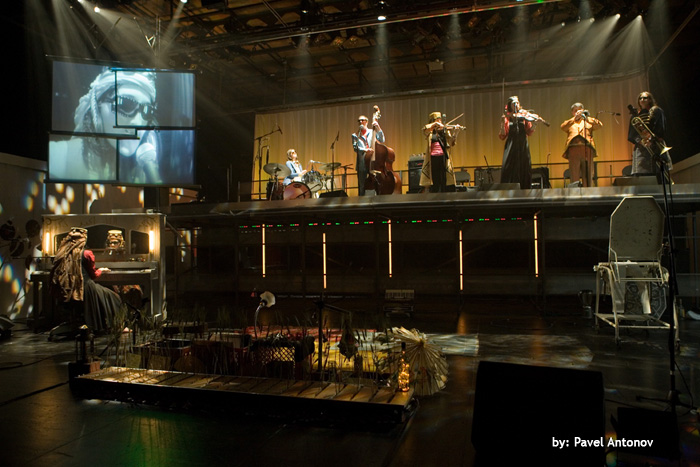 Must Don't Whip 'Um [Jeff Sugg: co-Set, Video, & Production Design]Next week the Occupational Art School Node #1 will launch its new website, post our sign-up forms and terms, and build out our social media array a bit. A lot to do! Let us know if you have any questions.
Must Don't Whip 'Um [Jeff Sugg: co-Set, Video, & Production Design]Next week the Occupational Art School Node #1 will launch its new website, post our sign-up forms and terms, and build out our social media array a bit. A lot to do! Let us know if you have any questions.
 BUSHWICK,
BUSHWICK,  OAS Node #1,
OAS Node #1,  bat haus,
bat haus,  eric leiser,
eric leiser,  jeff sugg in
jeff sugg in  occupational art school,
occupational art school,  updates
updates  Friday, August 10, 2012 at 05:37PM
Friday, August 10, 2012 at 05:37PM 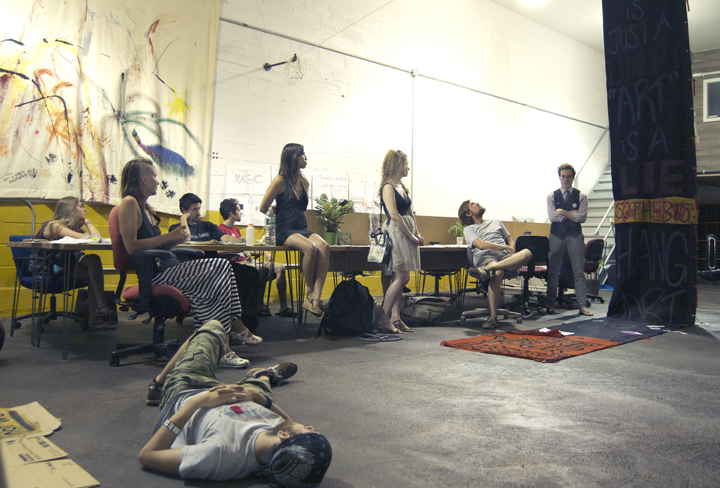 Bold Jez & anarchivists during the presentation "Recording Future History" at OAS Node #1 pre-launch #TITMOTA at BAT HAUS[LINK to photoset on the Bat Haus Tumblr]
Bold Jez & anarchivists during the presentation "Recording Future History" at OAS Node #1 pre-launch #TITMOTA at BAT HAUS[LINK to photoset on the Bat Haus Tumblr]
Last night the Occupational Art School celebrated the Anarchives and their inventor Bold Jez, as the ghost of Peter Cooper floated monumental over our shoulders, invisible at times in the light. Special guests DAF encouraged rubbings and created a typological street intervention. We shared cookies, Etherpad, avocados, reflections on pre-9/17 Arts & Culture stunts, chronicles of Magic Mountain, QR Codes, artifacts of occupation [+]. An electrified hula dancer performed, and a poet. Bushwick passed by, asked questions, and we tried to provide true answers. The event was free.
 Wednesday, August 8, 2012 at 12:52PM
Wednesday, August 8, 2012 at 12:52PM BY PAUL McLEAN
The Occupational Art School commences its program auspiciously with "Time in the Mind of the Anarchive," a conversation-starter in two [2X∞] parts, #TITMOTA 1+2. The opening festivities slated for Thursday, August 9 at 7PM at Bat Haus in Bushwick include a presentation by Bold Jez, a/k/a Jez Bold, a/k/a Jeremy, a/k/a Jez3PREZ, etc., entitled "Recording Future History: Activist archivism in Occupy Wall Street." The actuality of our expo is N+1-oriented, so come prepared. It's a hot summer in Brooklyn, and 11 months after the first interventions in and around Wall Street popped up, the promise of occupation is a multi-faceted proposition, if not an outright seduction, to be fulfilled. #TITMOTA is therefore a beginning that looks behind us, over our shoulders. The movement, if that what it is and was, or will be, has never been subject to the embedded command of prediction. Although OWS has exclaimed its advocacy for the 99%, no 99% has embraced it. In America, at least, popular change is a spectator sport. For the vast silent masses of Americans, quasi-citizens, Occupy could have as well been the Olympics. OWS has been much more real for the 1%, who are so close to complete victory, their sphincters clang shut at the first sign of popular dissent.
 TITMOTA,
TITMOTA,  bat haus,
bat haus,  occupational art school in
occupational art school in  coolest shit ever
coolest shit ever  Sunday, August 5, 2012 at 04:55AM
Sunday, August 5, 2012 at 04:55AM  TITMOTA,
TITMOTA,  bat haus,
bat haus,  jez bold,
jez bold,  occupational art school in
occupational art school in  exhibition,
exhibition,  residency,
residency,  salon
salon  Sunday, July 22, 2012 at 09:34PM
Sunday, July 22, 2012 at 09:34PM
Updated on Tuesday, July 24, 2012 at 01:34PM by
 admin
admin
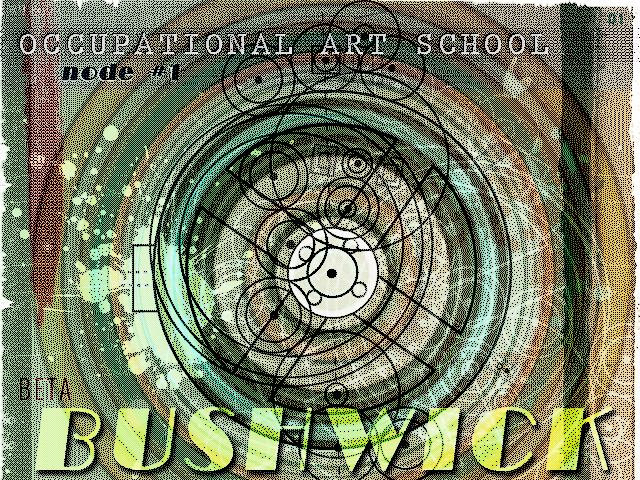
[SUMMARY]:
The Occupational Art School proposes to conduct a three-month long residency at Bat Haus in Bushwick. The programming will consist of workshops, screening series, a reading group, exhibits and other arts, cultural and educational exchanges. What follows is a suggested outline of the residency, created with the idea that we can adapt it to better suit the space, to meet client needs and interests, and to accommodate artists and instructors who approach us with interest in participating in OAS@Bat Haus.
 Sunday, July 15, 2012 at 12:15PM
Sunday, July 15, 2012 at 12:15PM Alternate Economies (Barter)
[Session 7]
[NOTES]: I took a page-and-a-half of notes during the two-hour seminar, which I would be happy to share. Caroline said she would follow-up by sharing her booklist on barter and alt.economies (gift/barter/market) and the slideshow she created for the presentation. The workshop provided participants an opportunity to examine our existing notions about barter, gifting and these non-monetary systems' place in society and markets. We examined anthropological work on the subject, including Graeber's from Debt. Caroline cited the work of Caroline Humphrey on the nomadic Lohmi traders of Tibet as a prime influence, and also works by Allan Fiske and Marshall Sahlins. I think Louise Ma of Trade School was one of the attendees of our workshop; OurGoods and Trade School are I gather operating on a mutual aid basis, with some core members (like Caroline Woolard) in both orgs. Caroline also gave examples of barter models, from ancient Greece to the local present, to expand our understanding of how barter has worked or can work in different kinds of situations and societies, and what limitations or hazards apply to barter in practice, rather than theory or analytics. Participants shared food and drink, engaged in a barter game/team session and at the end of the workshop shared "haves" and "needs" in the format of OurGoods.
∞
Authorship & Appropriation in Contemporary Art
[Session 8]
[NOTES]: (This entry is a stub/communique) Leaving EYEBEAM and the OurGoods workshop, I noticed a cool-looking artist happening on 21st... Turned the corner and noticed Max Schumann outside Printed Matter on 10th. He told me about the ambitious Printed Matter summer project HELP/LESS. Max invited me into the bustling artist bookstore, to check out the opening night's happ'nin's, which were awesome. Click on the image above for more details and the calendar of events. I think Max explained that the interactive art event I'd passed was connected to the opening, which made sense. Every time I visit PM, my respect for Max and this venerable Chelsea art-org grows. HELP/LESS is a compelling, must-see/-play exhibit cum program, diving into the murky swampwaters of art- and intellectual property-ism, post-web, post-modernism, post-reproduction/mechanical age, post-Dispersion, post-4chan, pre-image Apocalypse. The crush of content in the PM shop is introduced by a storefront (the same one we Occupied last fall) that appears to present art star worx that actually are derivatives or outright replicants. PM has fearlessly confronted in Habib's HELP/LESS the copyright (or -wrong) regime of idea ownership and originality/original-ism that besets the culture at every turn, from Tumblr to tee shirts to texts to the YouTube-infected art haus. Speaking of tee shirts, Max said I could score a Yoko Ono tee in exchange for a great idea at PM (quantities while they last, I presume)... Max is going to be busy for the next few months (he always is) - working on a CoLab book, co-ordinating the string of in-store and online events for HELP/LESS, and, we hope, finally getting to give us an Occupational Art lesson on artist books - the one we tried to do at the Spatial Occupation @Hyperallergic, but which didn't pan out for that residency.
∞
[Follow-up]: Met Cody and Natalie at Bat Haus; we are making progress on our discussion about OAS siting there... STAY TUNED!
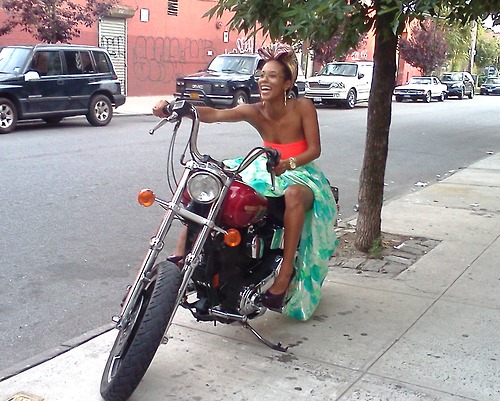 A photo from Bat Haus member & stylist Falosha Martin's shoot on location @BH. (click BH's blog link for more 411)
A photo from Bat Haus member & stylist Falosha Martin's shoot on location @BH. (click BH's blog link for more 411)
 bat haus,
bat haus,  chelsea,
chelsea,  eyebeam,
eyebeam,  printed matter in
printed matter in  WORKSHOP,
WORKSHOP,  exhibition,
exhibition,  projects
projects